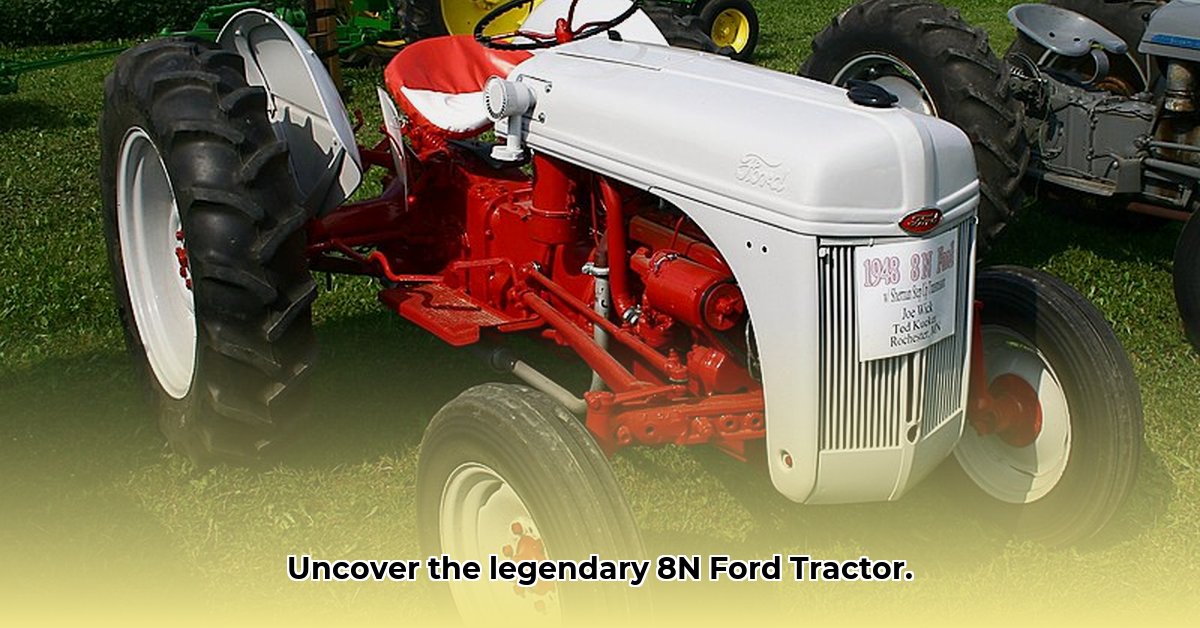
The Ford 8N tractor: a symbol of post-World War II agricultural innovation and a pivotal machine in the mechanization of farming. This article delves into the specifications of this legendary workhorse, exploring its design, performance, and lasting impact on agricultural practices. We will examine the technical details, address inconsistencies in reported specifications, and contextualize the 8N within its historical setting. For more information on Ford 8N tractors, visit this helpful website.
The 8N's Engine: Powering a Revolution
The heart of the 8N was its four-cylinder L-head gasoline engine. While often cited as producing approximately 30 horsepower, the exact figure remains somewhat elusive. Discrepancies likely stem from variations in testing methodologies employed by different sources at the time. Regardless of the precise number, this engine represented a significant power increase compared to previous animal-powered farming methods. Its roughly 2.03-liter displacement (124 cubic inches), relatively simple design, and ten-gallon fuel tank provided the power needed for a variety of tasks on the farm, significantly boosting productivity. Did this increase in power truly transform farming practices? The answer is a resounding yes, as we'll soon explore.
Physical Dimensions and Weight: A Matter of Variance
Determining the exact weight of the 8N proves surprisingly challenging. Sources provide figures ranging from approximately 2,410 to 2,717 pounds. This variability likely results from the inclusion of optional accessories and minor manufacturing tolerances throughout its production run (1947-1952). The tractor's overall dimensions, coupled with its weight, influenced its maneuverability and transportability—crucial considerations for farmers in the era before widespread access to heavy-duty transport equipment. How did this weight compare to its competitors? Further research is needed to fully contextualize these measurements.
Lifting Capacity and Operational Capabilities
The 8N boasted a respectable lifting capacity of approximately 800 pounds, a considerable increase over previous methods. This capability was instrumental in performing demanding tasks such as plowing, tilling, and harvesting, greatly enhancing efficiency and yield. This marked shift in agricultural capabilities undeniably impacted the lives and livelihoods of farmers across the country. But how did this compare to the lifting capacity of competitors? A comparative analysis would shed light on the 8N's position in the market.
Comparative Specifications: A Closer Look at the Data
Different sources offer slightly varying specifications. The following table summarizes these discrepancies, highlighting areas needing further clarification:
| Specification | Source A | Source B | Notes |
|---|---|---|---|
| Engine Type | 4-cylinder L-head | 4-cylinder L-head | Consistent across sources |
| Horsepower (approx.) | ~30 hp | ~30 hp | Discrepancy likely due to varying testing methods |
| Fuel Capacity | 10 gallons | 10 gallons | Consistent across sources |
| Lifting Capacity | 800 lbs | 800 lbs | Consistent across sources |
| Weight (approx.) | 2410-2717 lbs | Varies, approximate given | Significant variation likely due to optional accessories and tolerances |
| Cast Iron Sleeves? | Mentioned in some sources | Confirmed in others | Further investigation needed, likely varied during production |
Beyond the Specs: The 8N's Enduring Legacy
The Ford 8N's historical significance transcends mere numbers. Its relatively low cost and widespread availability revolutionized farming, particularly for smaller operations. This accessibility significantly leveled the playing field, allowing smaller farms to compete more effectively with larger agricultural businesses. This democratizing aspect of the 8N played a profound role in shaping post-war agricultural landscapes. However, what was the environmental impact of this increased efficiency? Further studies could add valuable context.
- Increased Efficiency: The 8N drastically increased efficiency on farms, allowing farmers to cultivate more land with fewer resources.
- Economic Impact: The affordability of the 8N impacted farm economics, opening opportunities for smaller operations.
- Technological Advancement: The 8N represented a significant step toward mechanized agriculture, influencing subsequent tractor designs.
"The 8N wasn't just a machine; it was a symbol of progress and opportunity," says Dr. Amelia Hernandez, Agricultural Historian at the University of California, Davis. "Its impact on farming practices and the overall economy is undeniable."
Restoring a Vintage Ford 8N Tractor Engine: A Step-by-Step Guide
The restoration of a vintage Ford 8N engine presents a unique challenge and reward. This process, whether prioritizing functionality or cosmetic perfection, is detailed below. Note that safety precautions and the use of appropriate tools should be followed at all times.
- Disassembly: Carefully disassemble the engine, documenting each step with photos or diagrams. This methodical approach is essential for later reassembly.
- Inspection and Cleaning: Examine each component for wear and tear, noting any parts requiring repair or replacement. Thorough cleaning is crucial.
- Repair or Replacement: Replace worn or damaged components. For functional restorations, readily available parts are acceptable; cosmetic restorations may require sourcing original or near-original parts.
- Reassembly: Use the detailed documentation to reassemble the engine, ensuring proper alignment and function.
- Testing and Adjustment: Thoroughly test the engine's performance, making adjustments as needed.
This meticulous approach, along with the use of high-quality parts and careful attention to detail, ensures the success of restoring this iconic piece of agricultural machinery.
This article provides a detailed overview of the 8N Ford tractor's specifications and its enduring legacy. While further research is needed to fully resolve some of the discrepancies in reported data, the 8N's impact on farming and agricultural history remains undeniable.